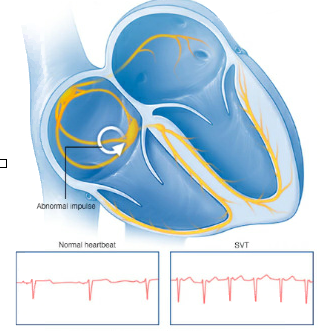The heart has two upper chambers (atria) and two lower chambers (ventricles). In normal rhythm, the heartbeat begins in the sinoatrial (SA) node, which is the heart’s natural pacemaker in the right upper chamber. The SA node sends out an electrical signal, which causes the atria to contract. This signal then moves throughout the heart’s electrical conduction system, causing the ventricles to contract. Supraventricular tachycardia is a rhythm originating in the upper chambers of the heart and leads to the heart beating exceedingly fast, sometimes upwards of 200 beats per minute. Supraventricular tachycardia is the most common type of arrhythmia in infants and children.

There are three major types of supraventricular tachycardia:

For some people, the SVT is inherited. For some people, an SVT episode is related to an obvious trigger, such as psychological stress, lack of sleep, or physical activity. For others, there may be no noticeable trigger. Things that may lead to, or cause, an episode include:

Heart failure

Thyroid disease

Heart disease

Chronic lung disease

Smoking

Drinking too much alcohol

Consuming too much caffeine

Drug use, such as cocaine and methamphetamines

Certain medications, including asthma medications and over-the-counter cold and allergy drugs

Surgery

Pregnancy

Certain health conditions, such as Wolff-Parkinson-White syndrome
Some people with SVT feel no symptoms and may not even know that they have SVT. Other people may have symptoms occurring on an intermittent or persistent basis and may experience any combination of any of the following symptoms:

A pulsing feeling in your neck

A tight feeling or pain in your chest

Dizziness

Fainting

Fluttering feelings in your chest (palpitations)

In rare cases, SVT can cause sudden death.

Nausea

Shortness of breath

Tiredness
Your provider might also try to trigger an episode with other tests, which may include:
To prevent an episode of supraventricular tachycardia, it’s important to know what triggers the episodes to occur and try to avoid them. You might want to try:
Most people with atrioventricular nodal reentry tachycardia do not require medical treatment. However, if you experience prolonged or frequent episodes, your doctor may recommend or try: